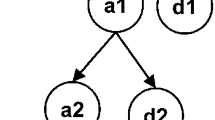Abstract
Brain–computer interface (BCI) technology provides a communication pathway using the human brain motor imaginary signal to develop applications like robotic hands and automated wheelchair, which are useful for the people who come with several motor disabilities. However, the signals which are acquired in a non-invasive approach come with various types of artifacts which badly effect on the accuracy of the prediction. For the above purposes, this paper proposes a model of human motor activity recognition using electroencephalogram (EEG) signal, in which three major time–frequency domain de-noising algorithms, i.e., Discrete Wavelet Transform (DWT), Empirical Mode Decomposition (EMD) and Savitzky–Golay filter are adopted for de-noising the signals acquired in a non-invasive approach. In this paper, initially, the EEG signals are de-noised using de-noising algorithm. After that, important statistical features from selected EEG channels of the dataset are extracted. Finally, the Support Vector Machine (SVM) classification algorithm is used for classifying particular motor activities. Those three major time–frequency domain de-noising algorithms are compared based on five comparison metrics, i.e., mean squared error (MSE), mean absolute error (MAE), signal-to-noise ratio (SNR), peak signal-to-noise ratio (PSNR), cross-correlation and the classification accuracy using SVM classification. For evaluating the proposed model, an online benchmarked dataset with four classes of motor activities has been used. Among the four classes, the first two classes are used in this research. Those are ‘Left-hand movement’ as Class 1 and ‘Right-hand movement’ as Class 2. The experimental result, the DWT-based de-noising method, shows optimal performance.
Access this chapter
Tax calculation will be finalised at checkout
Purchases are for personal use only
Similar content being viewed by others
References
Pandis D, Scarmeas N (2012) Seizures in Alzheimer disease: clinical and epidemiological data: Seizures in Alzheimer disease. Epilepsy Curr 12(5):184–187
Bizopoulos PA, Al-Ani T, Tsalikakis DG, Tzallas AT, Koutsouris DD, Fotiadis DI (2013) An automatic electroencephalography blinking artefact detection and removal method based on template matching and ensemble empirical mode decomposition. In: 2013 35th annual international conference of the IEEE engineering in medicine and biology society (EMBC). IEEE, pp 5853–5856
Indiradevi KP, Elias E, Sathidevi PS, Nayak SD, Radhakrishnan K (2008) A multi-level wavelet approach for automatic detection of epileptic spikes in the electroencephalogram. Comput Biol Med 38(7):805–816
Gao J, Zheng C, Wang P (2010) Online removal of muscle artifact from electroencephalogram signals based on canonical correlation analysis. Clin EEG Neurosci 41(1):53–59
Huang NE, Shen Z, Long SR, Wu MC, Shih HH, Zheng Q, Yen N-C, Tung CC, Liu HH (1998) The empirical mode decomposition and the Hilbert spectrum for nonlinear and non-stationary time series analysis. Proc R Soc London Ser A Math Phys Eng Sci 454(1971):903–995
Cohen L (1995) Time-frequency analysis, vol 778. Prentice Hall
Kopsinis Y, McLaughlin S (2008) Empirical mode decomposition based denoising techniques. In: 1st international work-shop on cognitive information processing (CIP)
Schafer RW (2011) What is a Savitzky-Golay filter. IEEE Signal Process Mag 28(4):111–117
Acharya D, Rani A, Agarwal S, Singh V (2016) Application of adaptive Savitzky-Golay filter for EEG signal processing. Perspect Sci 8:677–679
Fu MJ, Daly JJ, Cavusoglu MC (2006) Assessment of EEG event-related desynchronization in stroke survivors performing shoulder-elbow movements. In: Proceedings 2006 IEEE international conference on robotics and automation. ICRA 2006. IEEE, pp 3158–3164
Tandle A, Jog N (2015) Classification of artefacts in EEG signal recordings and overview of removing techniques. Int J Comput Appl 975:8887
Dai W, Selesnick I, Rizzo JR, Rucker J, Hudson T (2017) A nonlinear generalization of the Savitzky-Golay filter and the quantitative analysis of saccades. J Vis 17(9):10–10
Tangermann M, Müller KR, Aertsen A, Birbaumer N, Braun C, Brunner C, Leeb R, Mehring C, Miller KJ, Mueller-Putz G, Nolte G (2012) Review of the BCI competition IV. Front Neurosci 6:55
Author information
Authors and Affiliations
Corresponding author
Editor information
Editors and Affiliations
Rights and permissions
Copyright information
© 2020 Springer Nature Singapore Pte Ltd.
About this paper
Cite this paper
Jannat, N., Sibli, S., Shuhag, M., Islam, M. (2020). EEG Motor Signal Analysis-Based Enhanced Motor Activity Recognition Using Optimal De-noising Algorithm. In: Uddin, M.S., Bansal, J.C. (eds) Proceedings of International Joint Conference on Computational Intelligence. Algorithms for Intelligent Systems. Springer, Singapore. https://doi.org/10.1007/978-981-15-3607-6_10
Download citation
DOI: https://doi.org/10.1007/978-981-15-3607-6_10
Published:
Publisher Name: Springer, Singapore
Print ISBN: 978-981-15-3606-9
Online ISBN: 978-981-15-3607-6
eBook Packages: Intelligent Technologies and RoboticsIntelligent Technologies and Robotics (R0)




